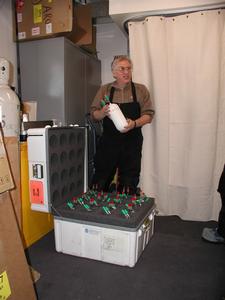29 November, 2001
Great deals of my recent journal entries have been devoted to the specific research I am involved in at the Dark Sector. However, the Amundson-Scott South Pole Base contains many sectors, each containing unique areas of research. One of my roommates, Dr. Russell Schnell, invited me to visit the Clean Air Sector.
The Clean Air Sector is an area covering a 130° range upwind from the Atmospheric Research Observatory (ARO) building. The Clean Air Sector is officially the zone free from human activities. Humans, except for the scientists conducting research in this area, cannot enter this zone because their mere presence will influence the data being collected.
Dr. Schnell enthusiastically shared all of the research being conducting at the Atmospheric Research Observatory. The two most well known long-term studies are monitoring ozone levels in the stratosphere and greenhouse gases, such as carbon dioxide and methane.
Ozone is a very important, but rare, gas in Earth’s upper atmosphere. The primary purpose of ozone is to protect Earth’s surface from harmful ultraviolet radiation emitted from the sun. Early in Earth’s history, before oxygen was abundant enough in quantity to form ozone, life was not capable of existing. Only after a thin ozone layer developed around our planet, was life able to take hold and flourish to its present diversity.
Under normal circumstances, ozone has a finite lifetime. Fortunately, humans and other animals that emitted oxygen during their respiration add more oxygen to the atmosphere. Some of this oxygen is chemically converted into ozone, which replaces the ozone depleted by natural processes. However, with as with many things, humans have thrown the natural equilibrium of Earth out of balance. Human activities, especially in the last century have released numerous chemicals into the atmosphere that destroy ozone, faster than natural processes can replace it.
The depletion of ozone was first discovered over Antarctica. Antarctica appears to receive the greatest ozone depletion because the chemical process for destroying ozone can only occur at very low temperatures. Each spring, as the sun peers above the horizon providing energy for chemical reactions, the ozone layer over the Antarctic continent actually gets depleted so much that it is described as a hole. This hole, which sometimes extends up to habited areas such as New Zealand, bombards the affected areas with deadly ultraviolet radiation. An interesting statistic confirming this fact is that New Zealand suffers the highest rate of skin cancer in the world. Fortunately, as the sun climbs higher over Antarctica, warming up the atmosphere, the upper atmosphere’s temperature gets to warm and the ozone destroying chemical reactions cease. Usually around the late November, the ozone hole begins to recover.
Since the ozone hole was discovered, many attempts have been made to control it. One international initiative was the Montreal Protocol, which banned the future production of known ozone destroying chemicals, such as chlorofluorocarbons. Unfortunately, the protocol does not restrict the use of already existing stockpiles of these harmful gases. It may be sometime before the ozone is restored to its original level. Until that time, all humans must be wary of spending too much time in the sun. People today are at a significantly higher risk of contracting skin cancer than people a generation ago.
In addition to studying ozone, the Atmospheric Research Observatory also studies greenhouse gases. There are numerous greenhouse gases, with carbon dioxide being the most well known. A certain amount of greenhouse gasses are necessary on Earth, for the trap heat in the atmosphere, like a warm blanket on cold winter morning.
The Earth is surprisingly heated from below by absorbing ultraviolet radiation from the sun and reemitting it as infrared radiation. Infrared radiation is also known as thermal radiation or heat radiation. Humans emit infrared radiation, which is evident when you feel the heat from another person’s hand. Most of the heat released by Earth would be lost to outer space, resulting in a very cold planet. Fortunately, there are certain gases that absorb and redirect the heat back towards Earth’s surface, causing the temperatures to be warmer than normal.
As stated above, certain amounts of greenhouse gasses are necessary. Since the start of the Industrial Revolution, humans have been releasing more greenhouse gasses into the atmosphere than normal. This excess has resulted in an increase in greenhouse gasses, such as carbon dioxide. Global carbon dioxide levels have been increasing about 10 part per million every five years. Unless carbon dioxide and other greenhouse gasses are reduced, the Earth will warm…a trend that many argue has already begun. If the nations of our world cannot unit to reduce greenhouse gases, our planet may end up similar to Venus, an extremely hot planet, incapable of supporting life, and void of oceans of water because they would have boiled away.
To learn more about the South Pole Clean Air Facility you can visit the website of the National Oceanic and Atmospheric Administration’s (NOAA) Climate Monitoring and Diagnostics Laboratory. Their website address is http://www.cmdl.noaa.gov and when the satellite is available, it is possible to see real time images of the site.
Biological Data
Saturated Oxygen: 89 %
Pulse Rate: 81
Weather Data
Temperature: -31.1
Wind Chill: -72.8

Dr. Russell Schnell explaining how atmospheric samples are collected.
Contact the TEA in the field at
.
If you cannot connect through your browser, copy the
TEA's e-mail address in the "To:" line of
your favorite e-mail package.
|
